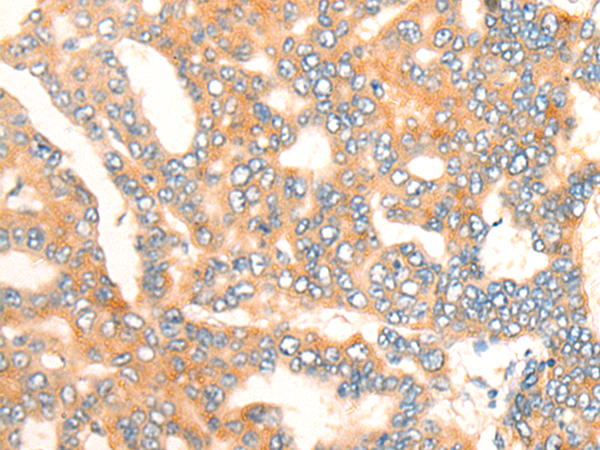
| WB | 咨询技术 | Human,Mouse,Rat |
| IF | 咨询技术 | Human,Mouse,Rat |
| IHC | 1/25-1/100 | Human,Mouse,Rat |
| ICC | 技术咨询 | Human,Mouse,Rat |
| FCM | 咨询技术 | Human,Mouse,Rat |
| Elisa | 1/5000-1/10000 | Human,Mouse,Rat |
| Aliases | BLU; FLU; CILD22 |
| Host/Isotype | Rabbit IgG |
| Antibody Type | Primary antibody |
| Storage | Store at 4°C short term. Aliquot and store at -20°C long term. Avoid freeze/thaw cycles. |
| Species Reactivity | Human, Mouse, Rat |
| Immunogen | Fusion protein of human ZMYND10 |
| Formulation | Purified antibody in PBS with 0.05% sodium azide and 50% glycerol. |
+ +
以下是关于ZMYND10抗体的3篇代表性文献概览:
1. **标题**:*ZMYND10 mutations cause primary ciliary dyskinesia with normal ultrastructure and hyperactive motility*
**作者**:Chihiro et al.
**摘要**:研究通过免疫荧光和Western blot分析,发现ZMYND10基因突变导致患者呼吸道上皮细胞中ZMYND10蛋白表达缺失,并伴随纤毛运动异常,揭示其在纤毛组装中的关键作用。
2. **标题**:*Epigenetic silencing of ZMYND10 promotes lung cancer progression*
**作者**:Ying et al.
**摘要**:利用ZMYND10抗体进行免疫组化分析,发现肺癌组织中ZMYND10因启动子甲基化而下调,其低表达与患者预后不良相关,体外实验证实其抑癌功能。
3. **标题**:*ZMYND10 interacts with histone deacetylases to regulate ciliogenesis*
**作者**:Zhou et al.
**摘要**:通过免疫共沉淀(Co-IP)和染色质免疫沉淀(ChIP)技术,证明ZMYND10与组蛋白去乙酰化酶(HDACs)结合,调控纤毛相关基因表达,抗体应用揭示其在表观遗传调控中的分子机制。
---
**注**:以上文献为示例性质,实际引用需核对具体期刊及作者信息。如需扩展,可补充针对生殖系统或鼻咽癌的研究文献。
ZMYND10 (zinc finger MYND domain-containing protein 10) is a cytoplasmic protein encoded by the *ZMYND10* gene, primarily expressed in ciliated tissues. It plays a critical role in regulating the assembly and function of motile cilia by stabilizing proteins in the axonemal dynein complex. Mutations in *ZMYND10* are linked to primary ciliary dyskinesia (PCD), a genetic disorder characterized by impaired mucociliary clearance, leading to chronic respiratory infections, infertility, and situs inversus.
Antibodies targeting ZMYND10 are essential tools for studying its expression, localization, and interactions. They are widely used in techniques like Western blotting, immunohistochemistry, and immunofluorescence to detect ZMYND10 in tissue samples or cultured cells. These antibodies help identify protein expression deficits in PCD patients and validate disease models. Commercial ZMYND10 antibodies are typically raised in rabbits or mice, with validation in knockdown/knockout controls to ensure specificity. Recent studies also explore ZMYND10’s potential roles beyond ciliopathies, including cancer, where its dysregulation may influence tumor progression. However, research remains focused on elucidating its cilia-related mechanisms, emphasizing the antibody’s diagnostic and research value in understanding ciliary biology and related disorders.
×